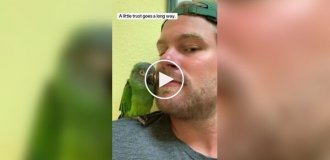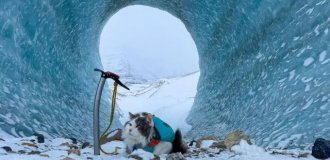The most unusual prehistoric animals (10 photos)
Some of these representatives are similar to the inhabitants of today's aquarium or zoo, while others are very strange and scary. In any case, they all died out millions of years ago. Below we will talk about ten of the strangest prehistoric animals, albeit not as well known to us as dinosaurs.
The useful skills of archaeologists constantly increase their knowledge, expanding the list of hitherto unknown living creatures that once lived on Earth. Scientists are also trying to find out whose ancestors they are in order to more fully trace the chains of evolution on the planet.

Dunkleosteus. This prehistoric fish looks like something out of nightmares. The representative of the genus of armored placoderm family is one of the largest among fish. An armored creature with powerful jaws roamed the oceans about 400 million years ago. The length of the dunkleosteus was 8-10 meters, and its weight was almost 4 tons. The creature was considered the top of the pyramid of predators, which meant that Dunkleosteus could not be the prey of other animals. The fish themselves ate meat as their main food. Such a terrible creature essentially had no teeth; instead, there were two pairs of bone plates in the mouth that helped crush the shells. Scientists concluded that the pressure of the fish's jaws was 55 MPa, which is comparable to a crocodile bite. The predator opened its mouth so quickly (1/50 of a second) that the stream of water simply sucked in the prey. The monster simply regurgitated the undigested remains. Fortunately, the creature became extinct during the late Devonian period, otherwise swimming in the ocean today might be much more dangerous. Although it is believed that after the Devonian period Dunkleosteus had no direct descendants, another fish, Titanichthys, can be mentioned. It is, however, also considered ancient. As a result, Dunkleosteus can be considered a shark that lived 400 million years ago. In any case, we can associate today's predators with this giant, scary fish.

Archeopteryx. Many scientists call this creature the first bird, and it is also the most primitive that has ever existed. Archeopteryx lived at the end of the Jurassic period in the south of modern Germany about 150 million years ago. At that time, in place of Europe there was an archipelago of islands. The prehistoric animals were about one and a half feet long, about the size of a modern crow. Although the creature seems like a small, harmless bird to us, it actually had wide wings and sharp teeth like a crocodile. At the end of the wings there were fingers with sharp claws. One toe was hyper-elongated, dubbed the "killer claw". Scientists have concluded that Archeopteryx was more related to dinosaurs than to birds. The creature may have become the first of its kind, marking the beginning of a new generation of animals. Dinosaurs received the first attributes of birds, and over time they learned to fly, mastering new possibilities of existence. Archeopteryx mastered low bushes, perhaps even carrying out some kind of primitive flights (gliding).

Elasmosaurus. This creature lived during the Late Cretaceous period, about 80 million years ago. Elasmosaurus reached 14 meters in length and weighed more than 2.2 tons. Half of the animal's length was in its neck, which had more than 70 vertebrae. This is more than any other creature known to science today. But the long neck was an important part of the body, which could protrude far out of the water. It seems that such a large volume of mass should be accompanied by powerful flippers, but fossils found in Kansas told scientists that there were only 4 of them, and they were also small in size. The animal’s body was crowned with a small head, but its teeth were very sharp. It fed on small fish and shellfish, making sudden movements with its cervical region. Elasmosaurus is not closely related to modern animals, but is distantly related to reptiles. If you believe in the Loch Ness monster, then this prehistoric animal may be what you've been waiting for. There have been extremely few other creatures like this in history. Among paleontologists, by the way, there is a legend about how, during the reconstruction of the animal, its head was placed at the end of the tail, and not the neck.

Deinotherium. These creatures lived during the Middle Miocene era, becoming extinct during the Early Pleistocene. It is the third largest land animal that has ever existed on the planet. The height of the deinotherium was about 5 meters, and the weight was more than 15.4 tons. The creature is very similar in appearance to modern elephants, the only difference being a shorter trunk and tusks attached to the lower jaw, and not to the upper, as now. The animals lived in the tropical forest, and their habits had much in common with elephants. The main food was plants, and it is possible that not only the trunk, but also the limbs were used to obtain food. Fossils of these animals have been discovered all over the world, mainly in Europe, Asia and Africa. It is the discovery of these remains with large teeth and fangs that is believed to have given rise to Greek beliefs in giant archaic creatures. One glance at the unreconstructed image of deinotheriums is enough to realize that they are the ancestors of elephants. The creatures are also related to gomphotheres and mastodons, now extinct.

Opabinia. Archaeologists hope to find more than just twenty of these creatures and learn more about them. Known fossils of Opabinia have been found in British Columbia. In its appearance, this animal in no way corresponds even to prehistoric times. The species lived on the seabed, its soft body was about 7 centimeters in length. There were 5 eyes on the head, and the mouth was at the end of a movable two-centimeter proboscis. The body of Opabinia was segmented, each section had its own pair of lobes. Most of the time the animal crawled along the bottom, using its proboscis to look for its prey - bottom animals. However, in case of danger, Opabinia could swim, bending its body and flapping its blades. When the fossilized remains of these animals were discovered, scientists quickly decided that this species could not be related to any of the living ones. However, numerous studies have made us think about the relationship with arthropods and worms. Other scientists believe that Opabinia was the ancestor of tardigrades.

Helicoprion. This animal became famous for its dental spiral. Helicoprion is believed to have lived during the Carboniferous period. It is believed that this fish was one of the few that survived the Permo-Triassic mass extinction. But at the end of the Triassic period the creature finally became extinct. Although few fish remains remain, scientists discovered an unusual dental helix and several jaw bones. With their help, possible images of the animal were recreated. What is certain is that he had teeth similar to a circular saw located on his lower jaw. There were so many teeth that the older ones were pushed into the middle, creating a new turn of the spiral. However, new theories say that the spiral could be located in the pharynx area, remaining invisible from the outside. This structure of the sea creature made it possible to hunt better. Thus, a spiral could be used to cut tentacles, injure fish, or dig up shellfish. The length of such unusual creatures reached 2-3 meters, based on the diameter of a typical spiral of 25 centimeters. True, there were also dental formations of 90 centimeters, which gives reason to believe that the length of helicoprions is up to 9-12 meters. Although the fish are very similar to modern sharks, they represented primitive cartilaginous fish, close to the ancestors of modern marine predators.

Quetzalcoatlus. This creature is called one of the largest, if not the largest, of all who have ever roamed the heavens. Its name is associated with the Aztec god Quetzalcoatl, who was known in the form of a feathered serpent. The flying creature lived in the late Cretaceous period. It was a real king of the sky, with a wingspan of 12 meters and a height of almost 10. However, the weight was quite small - up to a hundredweight, thanks to the hollow bones. The creature had a sharpened key with which it collected food. The long jaws were not hampered by the lack of teeth, and the main food could be fish and the corpses of other dinosaurs. Fossils were first discovered in Big Bend Park, Texas in 1971. It is believed that while on the ground, the four-legged animal was so strong that it could take off straight from its spot, without a run-up. It is, of course, difficult to compare this huge animal with modern ones. Since it was a pterosaur, it had no direct descendants. But at one time it was most associated with Pteranodon, which is already comparable to modern birds, in particular the marabou stork. Two facts bring them together - a larger than usual wingspan and a predilection for carrion as food.

Dimorphodon. This medium-sized pterosaur lived during the early Jurassic period, about 200 million years ago. His fossil remains were found in 1828 in Great Britain. The animal's name comes from a Greek word meaning "two-shaped tooth." The name was given by Richard Owen in the hope of focusing research on its difference from other members of the reptile family. The creature had two different types of teeth in its jaws, which was rare for the family. Dimorphodon reached a height of about a meter; its neck was small, unlike its head, up to 30 centimeters long. The wingspan reached 1.5 meters. The tail had 33 vertebrae, which could presumably serve as a balancing mechanism when walking and certainly used in flight. Scientists still cannot come to a consensus - whether Dimorphodon moved on four limbs or on two. Today, the connections of this animal with any of the modern ones are unknown. Scientists believe that the reason for this is the weak connection of the pterosaur itself with dinosaurs. True, a relationship with the insectivorous Anurognathus is allowed, but this is also very controversial. We can ultimately say that Dimorphodon is generally a distant relative of all types of birds with wings.

Jackelopterus. The first fossils of a giant sea scorpion were discovered in Germany. This creature is one of the largest arthropods ever discovered. A fossilized claw of 46 centimeters makes it possible to assume the size of the scorpion itself - 2.5 meters. He lived in freshwater lakes and rivers about 400 million years ago. Then the oxygen content in the atmosphere was much higher, which was the reason for the appearance of giant animals. It is believed that scorpions were the first to colonize land. These ancient ancestors of today's crabs, spiders and scorpions were grouped together as Merostomata. Today there is evidence, despite its size, that Jackelopterus is a relative of these arthropods. Only, unlike its terrestrial descendants, this creature remained aquatic, for which it received the name “sea scorpion.”

Hallucigenia. In the late 1970s, Simon Conway Morris was studying strange fossils in British Columbia, Canada. Later similar ones were found in China. Scientists have come to the conclusion that prehistoric creatures were so strange that they could only exist in a dream. The creature was 0.5-3 centimeters long, it was elongated like a worm. However, the body was covered with three rows of appendages - two rows of spike legs, seven in each, and a row of tentacles on the back. A thickening was discovered at one end of the body, which was mistaken for the head. Surprisingly, no organs characteristic of this part of the body - eyes, mouth - were found. They were probably located in one of the sets of tentacles. Recent studies have shown that the animals had females and males, the latter having slightly more rounded shapes. Scientists still cannot understand exactly where the back of the animal is and where the front is, and how it moved. It is hypothesized that Hallucigenia is still a worm, with legs and spines to protect itself from enemies. Some paleontologists generally believe that such an independent animal did not exist at all, and that the discovered remains are part of a larger animal. As a result, it was decided to consider Hallucigenia as the ancestor of modern arthropods, in particular there is a close connection with velvet worms.





















